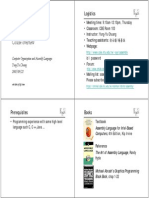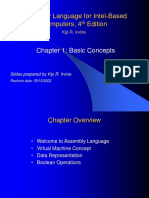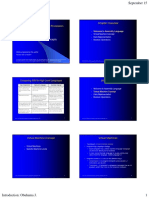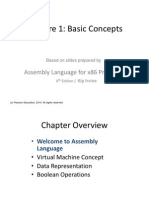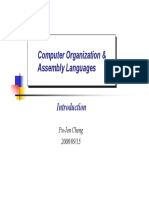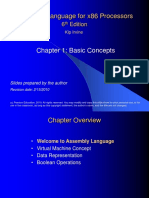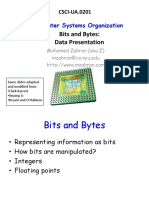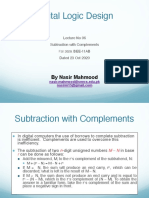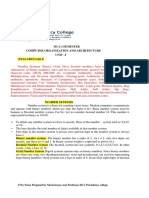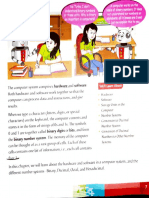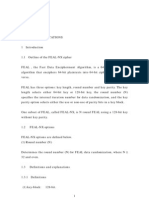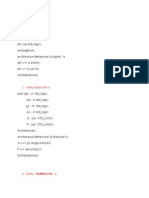Basic Concepts Chapter Overview
• Welcome to Assembly
Language
• Virtual Machine Concept
• Data Representation
Javed Ahmed Shahani
• Boolean Operations
Welcome to Assembly Language Some Good Questions to Ask
• Some Good Questions to Ask • Why am I taking this course (reading this
book)?
• Assembly Language Applications • What background should I have?
• What is an assembler?
• What hardware/software do I need?
• What types of programs will I create?
• What do I get with this book?
• What will I learn?
3 4
1
�Welcome to Assembly Language Assembly Language Applications
(cont)
• How does assembly language (AL) relate to • Some representative types of applications:
– Business application for single platform
machine language?
– Hardware device driver
• How do C++ and Java relate to AL? – Business application for multiple platforms
• Is AL portable? – Embedded systems & computer games
• Why learn AL?
(see next panel)
5 6
Comparing ASM to High-Level Languages Virtual Machine Concept
• Virtual Machines
• Specific Machine Levels
7 8
2
� Virtual Machines Translating Languages
• Tanenbaum: Virtual machine concept English: Display the sum of A times B plus C.
• Programming Language analogy:
– Each computer has a native machine language (language L0) that
runs directly on its hardware C++: cout << (A * B + C);
– A more human-friendly language is usually constructed above
machine language, called Language L1
• Programs written in L1 can run two different ways: Assembly Language: Intel Machine Language:
• Interpretation – L0 program interprets and executes L1 mov eax,A A1 00000000
instructions one by one mul B F7 25 00000004
• Translation – L1 program is completely translated into an L0 add eax,C
03 05 00000008
program, which then runs on the computer hardware call WriteInt
E8 00500000
9 10
Specific Machine Levels High-Level Language
High-Level Language Level 5 • Level 5
Assembly Language Level 4 • Application-oriented languages
– C++, Java, Pascal, Visual Basic . . .
Operating System
Level 3
• Programs compile into assembly
Instruction Set
Architecture Level 2 language (Level 4)
Microarchitecture Level 1
Digital Logic Level 0 (descriptions of individual levels
follow . . . )
11 12
3
� Assembly Language Operating System
• Level 4
• Level 3
• Instruction mnemonics that have a one-to-
one correspondence to machine language • Provides services to Level 4 programs
• Calls functions written at the operating • Translated and run at the instruction
system level (Level 3)
• Programs are translated into machine set architecture level (Level 2)
language (Level 2)
13 14
Instruction Set Architecture Microarchitecture
• Level 2 • Level 1
• Also known as conventional • Interprets conventional machine
machine language instructions (Level 2)
• Executed by Level 1 • Executed by digital hardware (Level
(microarchitecture) program 0)
15 16
4
� Digital Logic Data Representation
• Binary Numbers
• Level 0 – Translating between binary and decimal
• CPU, constructed from digital logic • Binary Addition
gates • Integer Storage Sizes
• System bus • Hexadecimal Integers
• Memory – Translating between decimal and hexadecimal
• Implemented using bipolar transistors – Hexadecimal subtraction
• Signed Integers
– Binary subtraction
• Character Storage
next: Data Representation
17 18
Binary Numbers Binary Numbers
• Each digit (bit) is either 1 or 0 1 1 1 1 1 1 1 1
• Digits are 1 and 0 • Each bit represents a power of 2: 27 26 25 24 23 22 21 20
– 1 = true
– 0 = false
• MSB – most significant bit
• LSB – least significant bit
Every binary
MSB LSB number is a
• Bit numbering: 1 0 1 1 0 0 1 0 1 0 0 1 1 1 0 0 sum of powers
15 0 of 2
19 20
5
� Translating Binary to Decimal Translating Unsigned Decimal to Binary
• Repeatedly divide the decimal integer by 2. Each
Weighted positional notation shows how to remainder is a binary digit in the translated value:
calculate the decimal value of each binary bit:
dec = (Dn-1 2n-1) + (Dn-2 2n-2) + ... + (D1 21) +
(D0 20)
D = binary digit
binary 00001001 = decimal 9:
(1 23) + (1 20) = 9
37 = 100101
21 22
Binary Addition Integer Storage Sizes
• Starting with the LSB, add each pair of digits, byte
word
8
16
Standard sizes:
include the carry if present. doubleword 32
quadword 64
carry: 1
0 0 0 0 0 1 0 0 (4)
+ 0 0 0 0 0 1 1 1 (7)
0 0 0 0 1 0 1 1 (11)
bit position: 7 6 5 4 3 2 1 0
What is the largest unsigned integer that may be stored in 20 bits?
23 24
6
� Hexadecimal Integers Translating Binary to Hexadecimal
Binary values are represented in hexadecimal.
• Each hexadecimal digit corresponds to 4 binary bits.
• Example: Translate the binary integer
000101101010011110010100 to hexadecimal:
25 26
Converting Hexadecimal to Decimal
Powers of 16
• Multiply each digit by its corresponding Used when calculating hexadecimal values up to 8 digits
long:
power of 16:
dec = (D3 163) + (D2 162) + (D1 161) + (D0 160)
• Hex 1234 equals (1 163) + (2 162) + (3 161) + (4 160), or
decimal 4,660.
• Hex 3BA4 equals (3 163) + (11 * 162) + (10 161) + (4 160), or
decimal 15,268.
27 28
7
� Converting Decimal to Hexadecimal Hexadecimal Addition
• Divide the sum of two digits by the number base (16). The quotient becomes the
carry value, and the remainder is the sum digit.
1 1
36 28 28 6A
42 45 58 4B
78 6D 80 B5
decimal 422 = 1A6 hexadecimal
21 / 16 = 1, rem 5
Important skill: Programmers frequently add and subtract the
addresses of variables and instructions.
29 30
Hexadecimal Subtraction Signed Integers
• When a borrow is required from the digit to the left, add 10h to
The highest bit indicates the sign. 1 = negative,
the current digit's value: 0 = positive
sign bit
10h + 5 = 15h
1 1 1 1 0 1 1 0
Negative
-1
C6 75 0 0 0 0 1 0 1 0 Positive
A2 47
24 2E
If the highest digit of a hexadecimal integer is > 7, the value is
Practice: The address of var1 is 00400020. The address of the next
variable after var1 is 0040006A. How many bytes are used by var1?
negative. Examples: 8A, C5, A2, 9D
31 32
8
� Forming the Two's Complement Binary Subtraction
• Negative numbers are stored in two's
complement notation • When subtracting A – B, convert B to its two's
• Represents the additive Inverse complement
• Add A to (–B)
00001100 00001100
– 00000011 11111101
Note that 00000001 + 11111111 = 00000000 01001.
Practice: Subtract 0101 from 0001001
33 34
Learn How To Do the Following: Ranges of Signed Integers
The highest bit is reserved for the sign. This limits the range:
• Form the two's complement of a
hexadecimal integer
• Convert signed binary to decimal
• Convert signed decimal to binary
• Convert signed decimal to hexadecimal
• Convert signed hexadecimal to decimal
Practice: What is the largest positive value that may be stored in 20 bits?
35 36
9
� Character Storage Numeric Data Representation
• Character sets
• pure binary
– Standard ASCII (0 – 127) – can be calculated directly
– Extended ASCII (0 – 255) • ASCII binary
– ANSI (0 – 255) – string of digits: "01010101"
– Unicode (0 – 65,535) • ASCII decimal
• Null-terminated String – string of digits: "65"
– Array of characters followed by a null byte • ASCII hexadecimal
• Using the ASCII table – string of digits: "9C"
– back inside cover of book
next: Boolean Operations
37 38
Boolean Operations Boolean Algebra
• Based on symbolic logic, designed by George
• NOT Boole
• AND • Boolean expressions created from:
– NOT, AND, OR
• OR
• Operator Precedence
• Truth Tables
39 40
10
� NOT AND
• Inverts (reverses) a boolean value • Truth table for Boolean AND operator:
• Truth table for Boolean NOT operator:
Digital gate diagram for NOT:
Digital gate diagram for AND:
NOT
AND
41 42
OR Operator Precedence
• Truth table for Boolean OR operator:
• Examples showing the order of operations:
Digital gate diagram for OR:
OR
43 44
11
� Truth Tables (1 of 3) Truth Tables (2 of 3)
• A Boolean function has one or more Boolean • Example: X Y
inputs, and returns a single Boolean output.
• A truth table shows all the inputs and outputs of
a Boolean function
Example: X Y
45 46
Truth Tables (3 of 3)
• Example: (Y S) (X S)
X
mux Z
Y
Two-input multiplexer
47
12




